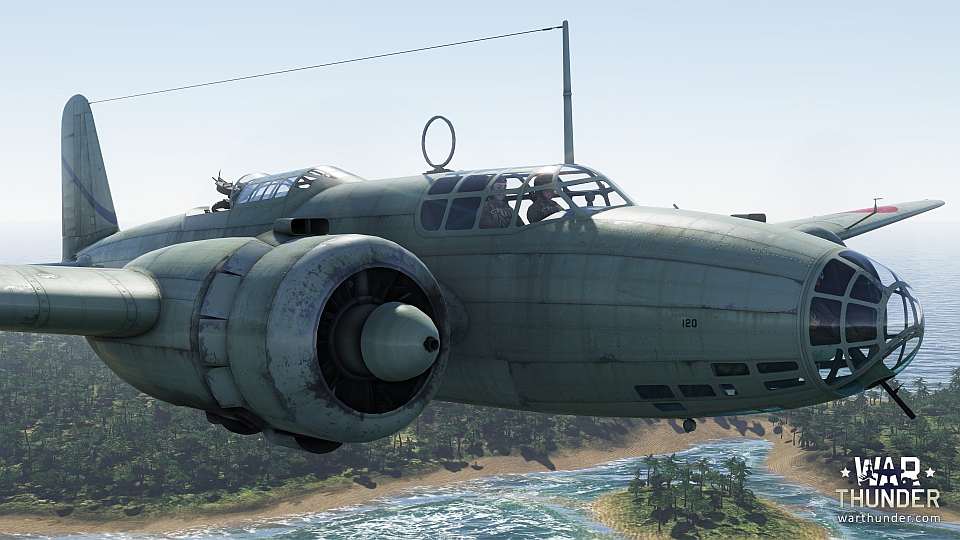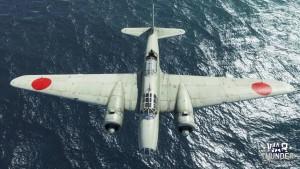War Thunder Ki-21-1ko
Source – http://warthunder.com/en/devblog/current/764
This aircraft has a maximum bomb load of 1000 kg, with different presets: 20×50 kg Type 94 bombs (four of them on external pylons); 10×100 kg Type 94 or Type 3 bombs (one of them on the external pylon); 4 x 250 kg Type 92 bombs; 2×500 kg Type 92 bombs. The defensive armament of the aircraft is two 7.7mm Te-1 machineguns; and an army twin-barreled 7.7 mm Type 89 “special” machine gun.
Questo aereo ha un carico massimo di 1.000 kg di bombe, con diversi preset: 20×50 kg Type 94 (quattro di loro sono su piloni esterni); 10×100 kg di type 94 o type 3 (di cui uno su pilone esterno); 4 x 250 kg Type 92 ; 2×500 kg Type 92. L’armamento difensivo del velivolo è: due 7,7mm Te-1 ; e una doppia canna 7,7 millimetri Type 89 “speciale” .
Kirill “Lassar” Vostretsov, Game Designer:
The first production army bomber of the Ki-21 line. Most clearly manifested itself with combat operations in China. Despite the common problem for all bombers at the time: weak defensive armament, no protection for the crew or the fuel tanks, a small bomb load – at the same time it had a great range of flight and speed in comparison with all existing aircraft of similar type around the world.
Si tratta della prima produzione del Ki-21. Venne principalmente usato in operazioni di combattimento in Cina. Nonostante il problema comune per tutti i bombardieri, al tempo: debole armamento difensivo, nessuna protezione per l’equipaggio o per i serbatoi di carburante, piccolo carico di bombe – allo stesso tempo ha avuto un vasto impiego grazie a capacità di volo e velocità rispetto a tutti gli aeromobili esistenti di tipo simile in tutto il mondo al tempo
Yuri Titarev, Artist:
With a relatively small size for a bomber, the polygon count for this model is one of the highest in the game, almost 87,000 polygons. This is due to the fact that a lot of attention was paid to creating the smooth, rounded shapes with this aircraft, typical of Japanese aviation. This aircraft has almost no sharp edges, all the elements are bound, polished and blended. Consequently, it was necessary to greatly increase the density of the mesh model to get smooth shading on any areas that were glazed. Also, an interesting feature of this aircraft was its landing flaps control system. Each plate consists of the 11 pieces, each of which has its own animation.
Con una dimensione relativamente piccola per un bombardiere, il numero di poligoni per questo modello è uno dei più alti in gioco, quasi 87.000 poligoni. Ciò è dovuto al fatto che molta attenzione è stata dedicata alla realizzazione delle forme arrotondate, tipica dell’aviazione giapponese. Questo aereo è quasi privo di spigoli, tutti gli elementi sono legati, con tecnica polished and blended. Di conseguenza, è stato necessario aumentare notevolmente la densità del modello di mesh ottenere ombreggiatura uniforme su tutte le zone che sono state smaltate. Inoltre, una caratteristica interessante di questo velivolo erano i suoi flap per il sistema di controllo dell’atterraggio. Ciascuna piastra è costituita da 11 pezzi, ciascuno dei quali ha una propria animazione (!)





